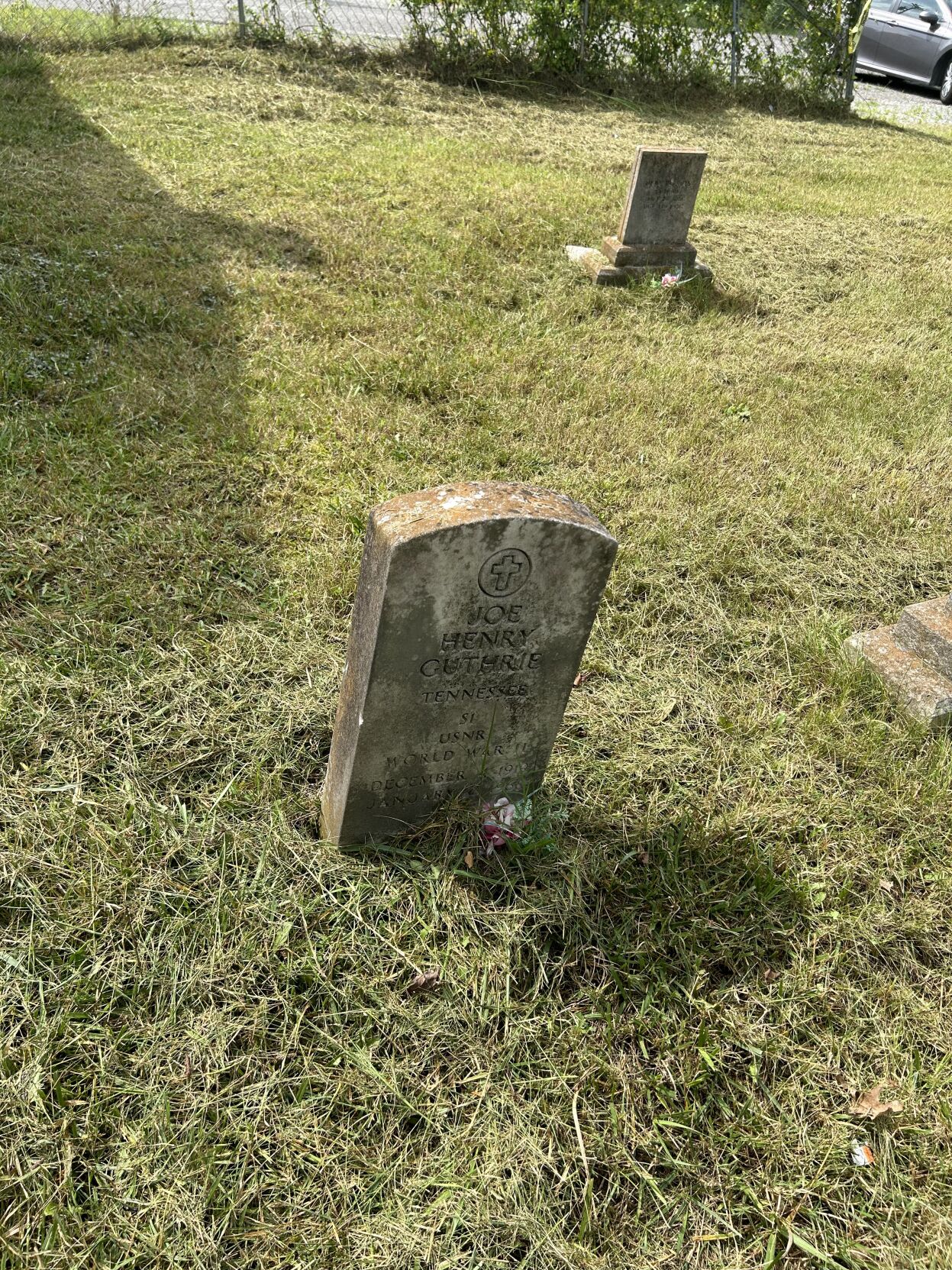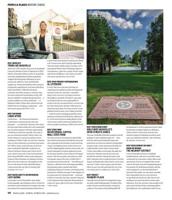
Olive Branch Missionary Baptist Church Cemetery
One of the first things Anissa Palmer said to me was, “I wanted the grass cut, but now I don’t want these people to be forgotten.” As you may have already guessed, she was talking about another small cemetery in some corner of rural Davidson County, filled with people’s loved ones. In this case, the Olive Branch Missionary Baptist Church Cemetery, where Palmer has relatives.
If you needed a guide for what to do when you find your loved ones in a neglected cemetery with knee-high grass where markers have fallen over and graves have sunken in, Palmer could write it. By the time she spoke to me, she’d already contacted Graham Perry at the state to make sure the cemetery was registered and mapped. She’d already spoken with Caroline Eller at the city to make sure the city knows about the state of the cemetery. She’d already spoken with Olive Branch Church about them needing to better maintain the cemetery. Hell, she had already accidentally cried in front of the groundskeeper at St. Kyrillos Coptic Orthodox Church, which now owns the property that surrounds the cemetery, when she saw the contrast between how the church property is maintained and how the cemetery property — which, to be clear, is not owned by St. Kyrillos — is not. The groundskeeper offered to mow the cemetery for her, but she wants the church with the obligation to the cemetery to fill it.
The first thing that struck me when I got to the cemetery and pulled up Find-a-Grave to see who I would be visiting is that I already knew some of these last names. Mildred Scales is buried in Olive Branch. A Scales has a headstone carved by William Edmondson. Glenn Winstead? Edmondson had carved a headstone for Cora Winstead. Phoebie Owens Bolyjack? Edmondson carved a headstone for a Bolyjack and headstones for a handful of Owenses. No, I did not find any Edmondson headstones in Olive Branch, but in that small-town way, I no longer felt like I was visiting strangers. I was going to pay my respects to the families of people William Edmondson had cared for and may have been distantly related to.

Olive Branch Missionary Baptist Church Cemetery
The Tennessee State Library and Archives (slogan: “We have useful maps") has a number of useful maps of this area at this time. This map is from 1871 and shows the landowners, including Thompson in the place where we know the church, school and cemetery are about to be. Check out the names of Thompson’s neighbors.
Now let’s take a look at who the Olive Branch Church — the descendant church from the Olive Branch Missionary Baptist Church — says were the families that started said church:
For over one hundred thirty years, Olive Branch Church has made an impression on the Antioch, Tennessee community. The vision for the church was brought to fruition in 1875 when its first Pastor, Parson Whitsitt, and the Turner, Paskett, Battle, Burk, Thompson, Britton, People, Allen, King, Wilson, Guthrie, Sanders, Winsted, Gooch, Mingle, Flye, Boyd, Wray, Porter, Gray, Harding and Covington families founded it.
Same names. The families that started this church came from these farms. The thing, though, is that there were few enough people out in the area that, with knowing the last names, we can give a really good guess as to who the founders of the church were. In the case of Olive Branch, as is the case with most of rural Davidson County, there actually aren’t that many people out there. In all of what was District 6 in 1870, there were only 173 houses and 178 families. There were only 158 Black males and 151 Black females. According to the Olive Branch website, there were only 23 founding families of the church. In 1870, only 10 of those families lived in the district — the Pasketts, the Gooches, the Grays, the Turners, the Thompsons, the Battles, the Allens, the Guthries, the Whitsitts and the Sanderses.
Thanks to this, we can pretty easily narrow down who Parson Whitsitt was. The census gives us only two adult Black men living nearby in 1870: George Whitsitt, who would have been pushing 40 and had seven kids with his wife Sarah. He was dead by 1880, so while I don’t think that completely rules him out, it makes him the less likely candidate, leaving us with Carroll Whitsitt, born in 1835, married to Mary, with 8 kids. His youngest two kids were Anthony and Cleopatra, suggesting he was well-read. He had younger brothers and sisters who could have benefited from a school, and one of his brothers-in-law was a schoolteacher. By 1910, Carroll and his family had moved to North Nashville. Then they proceeded to have a terrible decade. Carroll and at least four of his children would be dead by 1920.

Olive Branch Missionary Baptist Church Cemetery
Anissa Palmer told me her family were Guthries. Her earliest Guthrie ancestor I could find was Jack Guthrie, born about 1850, married to Emmaline Thompson, born closer to 1860. In the 1870 census, they’re listed as John, 21, and Emma, 19. (After Jack dies, Emmaline is going to marry Rex Sanders and have a bunch more children with him.) The only other Guthries in the district are William, 32, and his wife Polly, 21. These are the Guthries who started the church — young farmworkers, who had just started families. The Allens listed as church founders? The only two Black Allens in the census are Sarah, 50, who worked for the white Guthries, and Jane, 18, who lived with William and Polly Guthrie (so my guess is that Sarah is Polly’s mom and Jane is her sister). Other founding families are much, much bigger than this, so who can say if, say, all the Pasketts were church founders? But we know some of them were, and their names are in the 1870 and 1880 censuses.
But let’s take a step back and appreciate what we’re seeing here. In the wake of what we might best think of as a genocidal crime against humanity where people literally had everything, even their own bodies and their own children, stolen from them, the very thing the people of Olive Branch created was an “us.” The Benevolent Society that was founded in Olive Branch that then started the cemetery was a group of people who could take care of each other. It had a known membership that changed only at the will of the members. Compared to even 10 years before the founding of the Benevolent Society, now the people of Olive Branch had a public place where they could bury their dead. Can you even imagine what that must have been like for, say, Sarah Allen, who had spent 45 years of her life enslaved, to have a place where she could know her loved ones were? In 1840, if you’d asked Sarah Allen, “Where are your parents? Where are your children?” chances are she might not have known. She certainly had no say in it, and people got sold off. But by 1875, she could stand in the church doorway — a church she and her community built — looking over at the cemetery where her dead loved ones would go, and see just beyond, the school her grandchildren attended.

Olive Branch Missionary Baptist Church Cemetery
And to have a church and a school they controlled? A preacher and a teacher who looked like them? To have a deciding say in what was going into your own head and what you would learn? If Olive Branch had this 10 years after the end of slavery, we all know this is something they wanted while enslaved. And not just them, right? It seems like now that I know what to look for, I’m seeing these little communities everywhere. But in the case of this part of Davidson County, what we’re seeing seems even more remarkable. It’s not just that formerly enslaved people clustered together in little isolated rural communities that thrived unnoticed and then forgotten by the rest of us — what we know from studying William Edmondson is that the “us” of this area stretched from at least Olive Branch (though there is an Edmondson down in Eagleville, so maybe I’m drawing my boundaries too small) clear over to the other side of Hillsboro Road, close to where the Warner parks are and up into Edgehill and North Nashville. And how long did this “us” survive? Anissa Palmer said that, when she was a child, people at Olive Branch were sometimes baptized at Lake Providence, because Lake Providence had the proper equipment. So, to today.
This “us” that stretched over multiple communities and multiple church denominations that was forged in the hell of slavery and solidified in those terrifying, uncertain times of Reconstruction is still here. A hope and a promise that Emmaline Thompson’s mother, Charlotte Whittmore, and the other families of the area made to their families, their descendants — that there is a “we” that extends beyond life and death, beyond just the bounds of this land, beyond the whim of white people — is being fulfilled through Anissa Palmer and her relatives. Do I know what one of my however many great-grandmothers, born in 1820, wanted for me? I don’t even know if she could have conceived of me. But Charlotte wanted Anissa to have a school she could go to, a church she could attend, and Charlotte wanted a place where Anissa could find her, should Anissa ever go looking.
And not just Anissa, right? These early church founders wanted to be there for the church forever. So I get why it stings Anissa and her family that the church is neglecting the cemetery instead of honoring it. But man, also, what a loss for the church. To be given such a gift and to leave it at the side of a road down in the hills of Antioch because you don’t recognize its value?
That is a deep shame.




